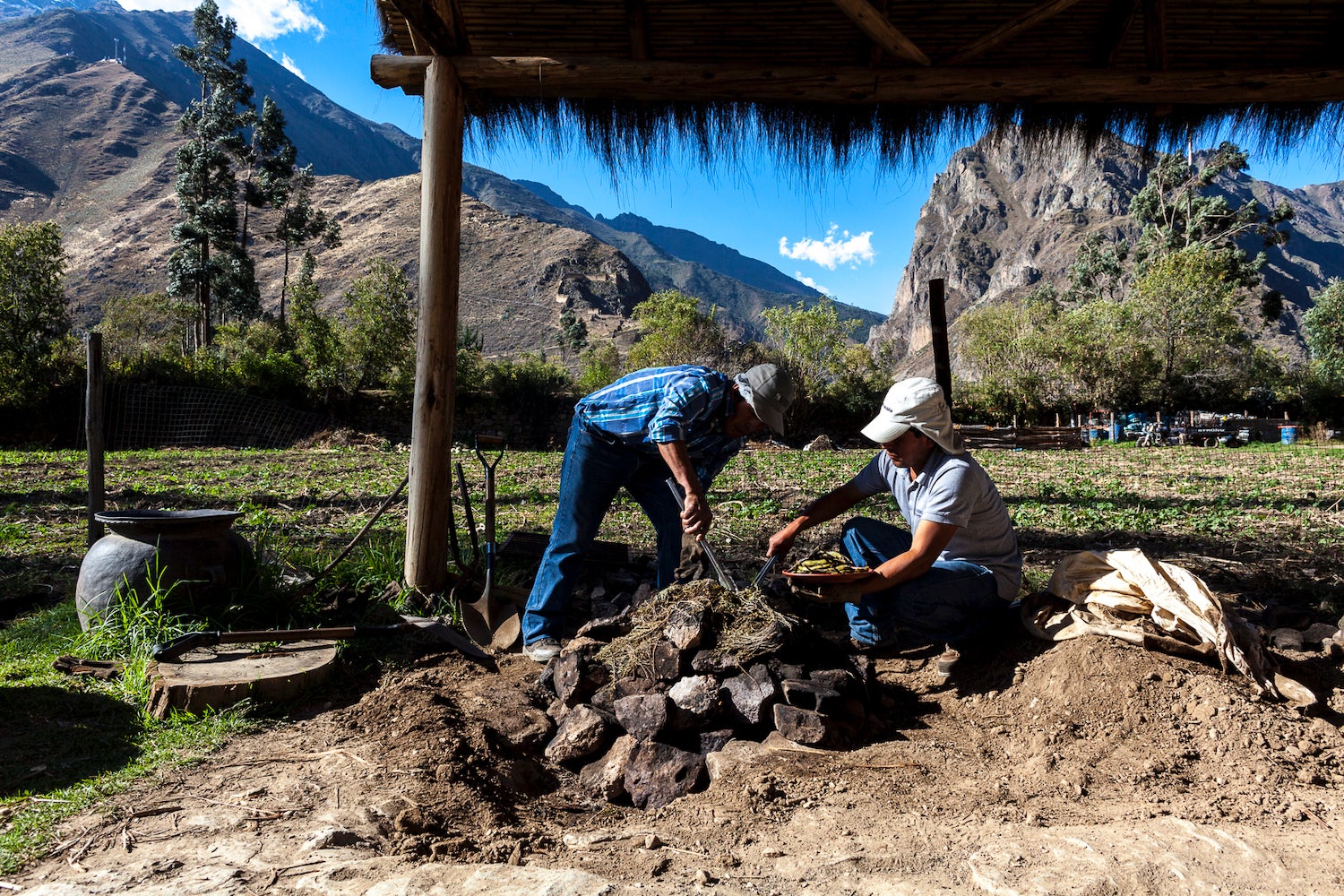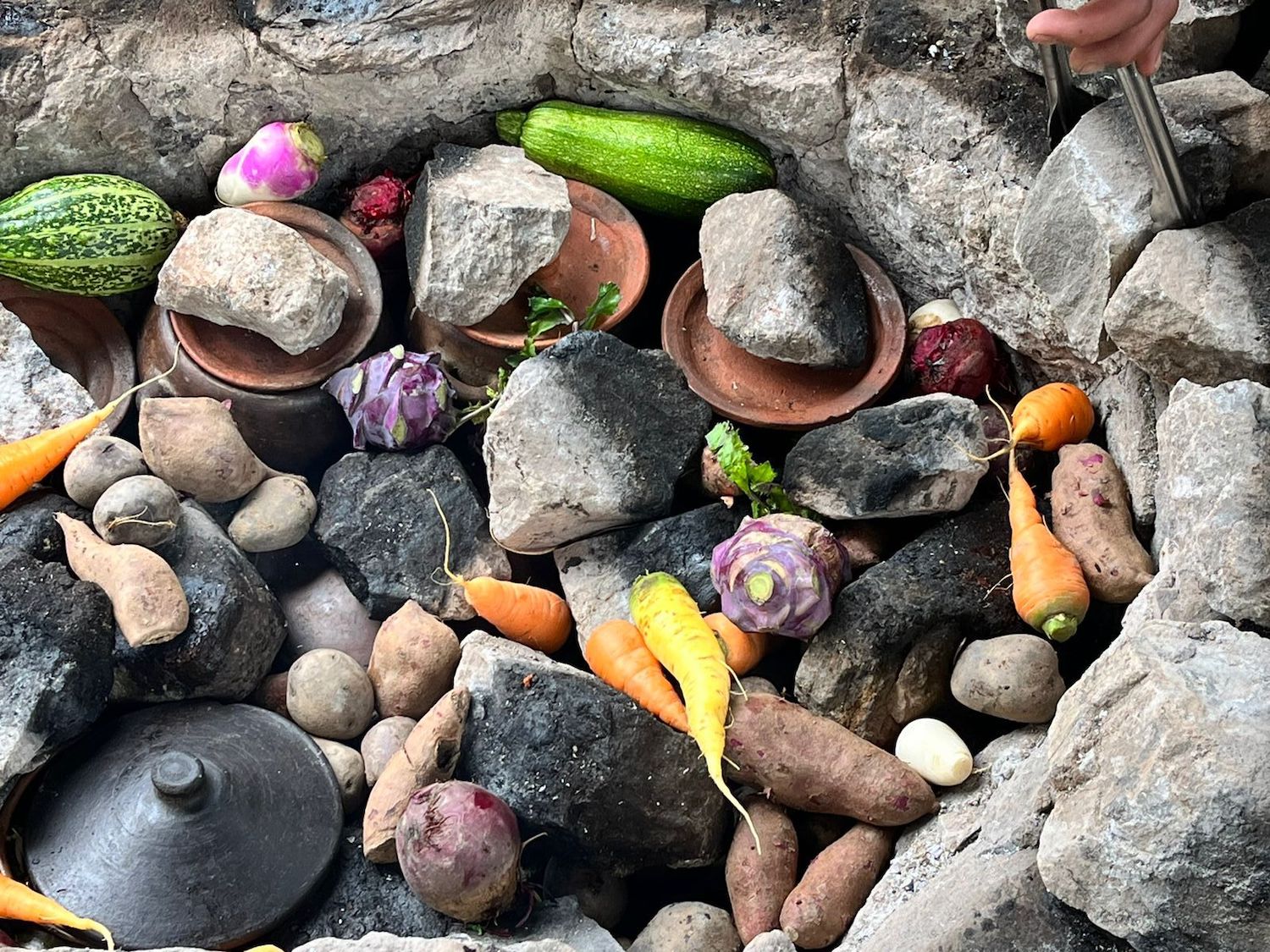Since its introduction at the National Housewares Show in Chicago in 1971, the electric slow cooker has become a household staple. The original Crockpot retailed for $25 (about $170 today), yet it sold 80,000 units in its first year. By 1975, the number had jumped more than 40-fold, thanks to the slogan “cooks all day while the cook’s away,” which promised middle-class American women the convenience and freedom to spend less time in the kitchen as they began making their way into the workforce.
But long before the gadget became the go-to method for preparing bean stews and pot roasts over the course of a busy workday, the technique of slow cooking was both a way to cook resourcefully with small amounts of fuel and a sacred ritual. Australia’s Aboriginal peoples cooked the roots of murnong plants overnight in mirnyong ground ovens warmed by heated clay. Hawaiians have traditionally buried a whole pig wrapped in banana leaves in imu earth ovens with sizzling rocks to slow cook all day. And in Peru’s Andes Mountains, Quechua communities place tubers, corn, and alpaca steaks in a pachamanca—a dirt-covered earthen oven fueled by hot stones that bakes and steams the layered ingredients.
From Tierra del Fuego to Alaska, earthen oven cooking has been a traditional technique for Indigenous people for millennia. In Chile, the Mapuche baked meat, fish, and vegetables in curanto ovens sealed with dirt and grass. The Gayón tribes of Venezuela cooked game and agave in earthen ovens covered by bijao leaves. In the Yucatán Peninsula, the Maya roasted meat and squash in píib ground ovens topped with maguey foliage. And in North America, archeological research dates earthen oven use to 10,000 years ago.
The process of building and cooking with an earthen oven, however, is fundamentally the same throughout the Americas, where Indigenous people typically implemented a five-step process: 1) dig a hole in the ground; 2) heat the rocks; 3) arrange the rocks at the bottom of the pit; 4) place the ingredients in the hole, sometimes layered; and 5) cover the pit with dirt or plants to seal the oven, allowing the radiant heat and moisture to slow cook the ingredients while infusing them with flavor.
From Tierra del Fuego to Alaska, earthen oven cooking has been a traditional technique for Indigenous people for millennia.
Indigenous chef, educator, and author Sean Sherman has been cooking, researching and revitalizing Native American cuisine through Minneapolis-based project The Sioux Chef. “In the Pacific Northwest, all the way up to Alaska, there’s seal protein; you’ve got game meat in general; the East Coast region has the shellfish clambake; and in the Southwest, the Navajo cooked kneel down bread, which is like a fresh corn tamale,” says Sherman about the diverse regions where Indigenous people cooked in earthen ovens.
In 2018, at the Culinary Institute of America’s Worlds of Flavor conference in California, Sherman did an outdoor earthen oven cooking demonstration in collaboration with chef Monique Fiso of New Zealand, where the Māori people call earthen ovens “hāngī.” “The Maori have the exact same style, too, so we built a shared earthen oven. She cooked some Maori dishes, and I did a tamale-like dish,” adds Sherman. To further preserve the Native American tradition of cooking underground, Sherman is planning to teach the earthen oven cooking method in an outdoor kitchen area of the Indigenous Food Lab.
Some 4,200 miles south of Minneapolis, at 9,000 feet above sea level in Peru’s Andes Mountains, Quechua communities in Ollantaytambo have preserved the 8,000-year-old knowledge of earthen oven cooking across generations for centuries. Adjacent to the town’s train station that takes tourists to Machu Picchu sits El Albergue—a 100-year-old hotel with a restaurant that cooks meals in a pachamanca. There, Isaac Riquelme is a pachamanquero—a pachamanca cook akin to the North American pitmaster.
“As a young child, before learning to make a pachamanca, my grandparents and parents taught me to make a huatia to cook our potato harvest,” says Riquelme about the small, aboveground, dome-shaped clod oven that he heated internally with wood fire, then collapsed over potatoes he’d placed inside to bake.

In the Sacred Valley, pachamancas were once reserved for special occasions, such as harvest celebrations or weddings, but El Albergue’s lunch guests can experience pachamanca cooking every day. The pachamanca, which is adjacent to their vegetable farm, is circular in shape, about 50 centimeters in diameter and 30 centimeters deep. Guests sitting at a wood table outdoors witness and participate in the process.
“We season the ingredients with chincho that grows next to the oven—there’s also a bit of huacatay, garlic, and salt from Maras, and nothing else,” explains Riquelme about the marinade with Andean herbs that infuses the food with the distinctive aroma of a pachamanca—wild mint. Even the salt is an expression of the local terroir and comes from salt evaporation ponds that pre-Inca communities have maintained in Maras.
“When the pachamanca is sealed, we place a cross on top, to protect us and so that everything cooks well,” says Riquelme of the Catholic symbol that illustrates a religious and cultural miscegenation in the Andes. To Quechua people, pachamanca cooking is a sacred practice, so to express their gratitude before opening the pachamanca, they make offerings of food, chicha corn beer, and coca leaves to Apu mountain gods and Pachamama—Mother Earth, who provides the ingredients and now cooks them within.
Years ago, inspired by the pachamanca cooking of my ancestors, I prepared a stove-top pachamanca dinner in San Francisco. First, I lined a tall pot with corn husks, then I layered the seasoned ingredients, added stock, sealed the pot with parchment paper and its lid, and cooked everything over low heat for an hour. But before opening the pachamanca a la olla, I invited guests to gather around a tree on the sidewalk outside the venue. Pouring beer onto the ground, I expressed gratitude to Pachamama in Quechua with the words “Imaymana mikhunqan kachun”—“Let there be unbounded food.”

For many home cooks, however, today’s average dinner doesn’t involve this much ceremony. The goal for busy families is to put food on the table. “I’m a mom, and I like to do things quickly, efficiently, and effortlessly,” says Stephanie O’Dea.
For O’Dea, New York Times best-selling author of the 2009 cookbook Make it Fast, Cook it Slow, the electric slow cooker is the modern-day answer to one of the most ancient and practical forms of cooking. O’Dea documented a yearlong foray into slow cooking every day of 2008 in an online recipe journal that includes diverse dishes such as baked potatoes, barbecue ribs, soups, and tamales, many of which made it into her cookbook.
In the American South, barbecue pitmasters slow cook meat in underground pits or raised ovens. But to re-create barbecue ribs at home, O’Dea turned to her slow cooker, seasoning ribs with a rub of salt, pepper, garlic, chile, vinegar, Worcestershire sauce, and Tabasco—then leaving it up to the slow cooker to make the ribs tender in seven hours. “Everything locks within the pot, creating this ecosystem where the moisture evaporates up onto the lid and then rains back down,” she says.
Whether you’re following O’Dea’s lead or building an earthen oven in your backyard, slow cooking requires time and faith, and an element of trust that what is being cooked is going to come out just right when you open the lid or uncover the pit in wonder. For Indigenous people, cooking in the earth is also a celebration, a feast of abundance honoring nature. In the Andes Mountains, Quechua people play music, drink, and dance after uncovering the pachamanca. Beyond that, underground cooking is a common culinary language uniting global cultures, from the past to the present.
First two photos by Adam L. Weintraub. Third photo by Joaquín Randall.